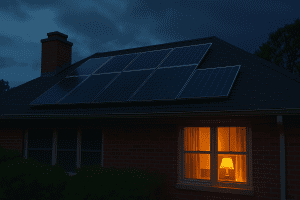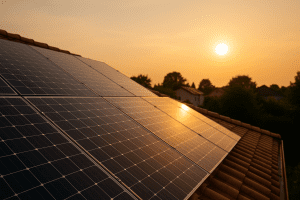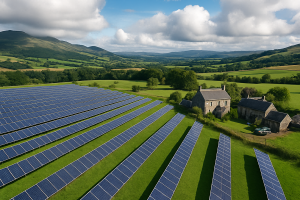How Much Can Solar Panels Save on Your Energy Bills?

Written By
- Manan Shah
Published on
- 22 Jun 2025
With energy costs becoming a growing worry for households, businesses, and public facilities across the UK, solar panels have gained significant attention as way to reduce reliance on the grid and gain more control over electricity expenses. But how much can solar panels actually save on your energy bills—and what are the factors which influence those saving?
This article explores the practical financial benefits of solar energy, explaining how savings are generated, what affects them, and why both homeowners and commercial property owners are increasingly exploring solar as a long-term energy strategy.
Why Energy Bills Are Driving the Solar Conversation
Energy prices in the UK have seen sharp increases in recent years, largely due to global market instability, supply issue, and demand fluctuation. For many, rising cost of electricity has made traditional energy model feel unsustainable especially when budgeting for the long time.
This volatility has encouraged both residential and commercial property owners to look into solar panels as a viable alternative. Rather than simply reacting to higher bills, solar offers a way to generate electricity independently and reduce exposure to price fluctuations over time.
How Solar Panels Help You Save
The financial benefit of solar panels come from self-generation you produce electricity on-site using solar energy instead of purchasing from utility provider. This reduces total volume of electricity you pay for the grid, especially during daylight hours when your panels are generating power.
For properties with solar battery storage, additional savings are possible by storing excess electricity for use during the evening or time of low sunlight, further decreasing grid reliance. Moreover, if your system produces more electricity than you need, you may be eligible to export that excess back to the grid under the Smart Export Guarantee (SEG), earning compensation in the process.
Also read: Solar Panels During Power Cuts: What UK Homeowners Need to Know
Estimated Savings: What Do the Numbers Say?
Exact savings vary significantly depending on the type of property, energy usage patterns, system size, and regional conditions. However, some general figure offer baseline:
Residential Properties
A 3.5 kW solar system can generate around 3,000 kWh per year.
Houses that consume more energy during the day can cut electricity bills by 30% to 70% depending on consumption habits and battery use.
According to data from the Energy Saving Trust, annual savings for a home with solar panels could range between £200 to £500, with higher figures possible if combined with battery storage and SEG payments.
Commercial & Public Sector Buildings
Commercial spaces often have larger roof space and daytime operation, making solar particularly more effective.
A medium-sized business might see thousands of pounds in annual saving, particularly when the system is sized appropriately for on-site consumption.
For care homes and schools, where electricity usage is relatively constant throughout the day, solar provides both financial and operational advantages.
Key Factors That Influence Solar Savings
Not all solar systems deliver the same results. Several factors will determine how much you can save:
1. System Size
The size of your solar Panel system directly impact amount of power you can generate. A system that closely matches your average energy use will offer the best value. Larger systems can generate more electricity but require more roof space and higher initial investment.
2. Energy Usage Patterns
Properties that consume more electricity during daylight hours tend to benefit the most. Businesses with 9–5 operations, care facilities with continuous usage, and homes where occupants are often home during the day can offset a larger portion of their bills.
3. Battery Storage
Adding battery storage to your solar system increases the percentage of self-consumed energy. Rather than exporting excess energy to the grid, a battery allows you to store it for later use, reducing your evening grid consumption.
4. Roof Orientation and Shading
South-facing roofs in the UK tend to deliver the best results. East- and west-facing roofs also perform well but may generate slightly less electricity. Shading from nearby trees, buildings, or chimneys can reduce output and affect savings.
5. Tariff Rates
The savings from solar energy are influenced by your current tariff. The higher your electricity rate, the more valuable each kilowatt-hour of solar electricity becomes. Similarly, the SEG tariff rate will affect how much you can earn for exporting excess electricity.
6. Installation Quality
Proper system design and professional installation are critical for maximising savings. Poorly configured systems or inefficient components can reduce performance over time.
Long-Term Financial Perspective
While upfront installation costs are often discussed, it’s the long-term return on investment (ROI) that makes solar financially appealing. Most residential systems have a payback period of 6 to 10 years, after which the electricity generated is essentially free for the remaining lifespan of the system—typically 20 to 25 years.
In the commercial sector, especially for organisations with large buildings or high daytime energy use, the ROI can be even quicker due to economies of scale and higher consumption levels.
It’s also worth noting that solar PV systems require minimal maintenance, and ongoing costs are generally low, which contributes to the overall savings.
Additional Benefits That Support Financial Value
While the core savings come from reduced electricity bills, several other benefits can contribute to the financial case for solar:
Property Value: Energy-efficient buildings often have higher market value and appeal to eco-conscious buyers or tenants.
Certifications and Compliance: For commercial and public-sector buildings, solar can support ESG reporting and compliance with sustainability frameworks.
Grid Independence: Reducing reliance on the grid adds energy security, especially during outages or future price hikes.
Predictable Energy Costs: Solar provides cost stability in a landscape of fluctuating rates and regulatory changes.
Who Can Benefit Most?
While solar panels offer some level of savings for almost any building, they are particularly well-suited to:
Homes with high daytime energy use
Businesses with regular working hours and high energy demand
Care facilities and schools with continuous energy usage
Properties with large, unshaded roof space
Organisations looking to improve sustainability and reduce long-term costs
In all of these cases, solar panels provide a pathway to both financial and operational improvement.
Making an Informed Decision
Deciding whether solar is right for your property starts with a proper assessment. This includes reviewing your energy usage, available roof space, and long-term goals.
Working with an experienced and certified installer helps ensure that your system is designed to deliver maximum performance and savings, tailored to your unique needs.









